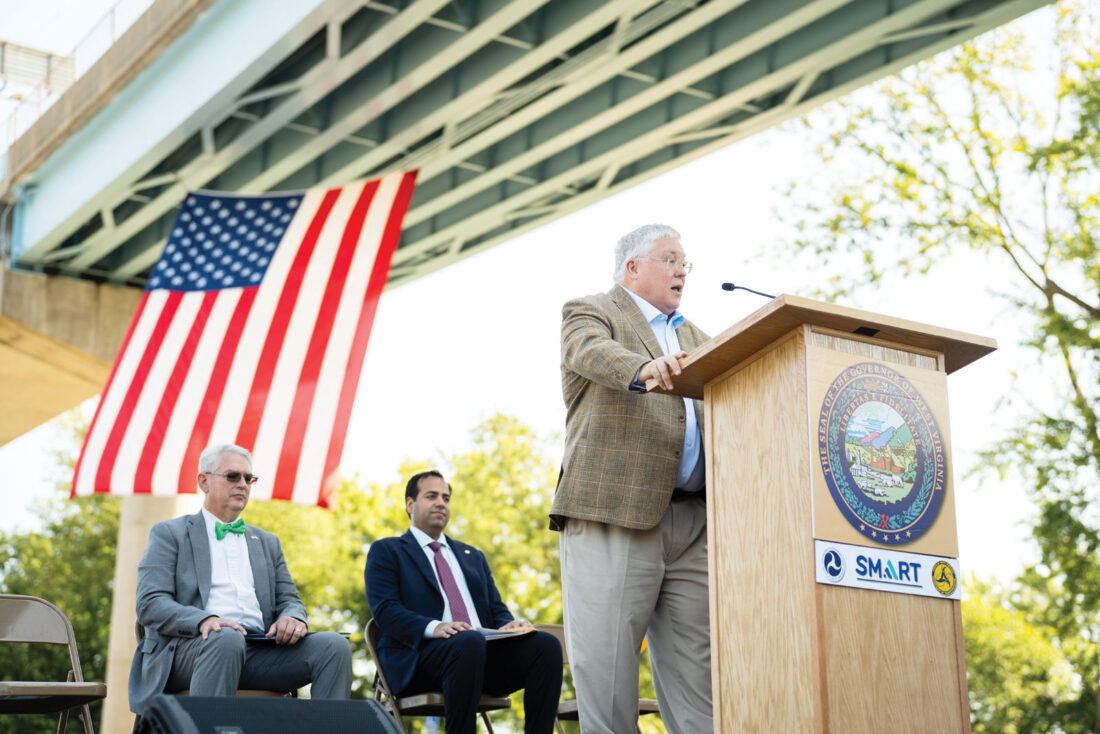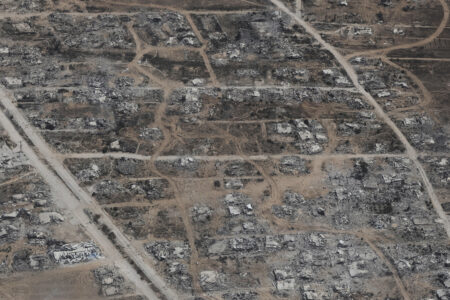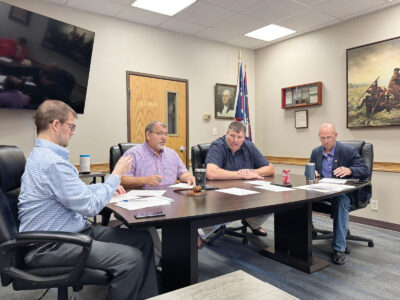Truss the Process: West Virginia transportation officials hope to roll out proactive bridge monitoring statewide

Gov. Patrick Morrisey, joined by state Department of Transportation Cabinet Secretary Stephen Todd Rumbaugh, left, and Shaz Umer, director of strategic initiatives for the U.S. Department of Transportation, right, praise West Virginia’s Structural Health Monitoring Project. (Photo courtesy of the West Virginia Governor’s Office)
CHARLESTON — A state and federal project underway for a Huntington bridge could be rolled out to other West Virginia bridges to identify structural issues before they become hazards. Gov. Patrick Morrisey and state Department of Transportation Cabinet Secretary Stephen Todd Rumbaugh joined Shaz Umer, director of strategic initiatives for the U.S. Department of Transportation, for an event Thursday morning in Huntington. The officials were celebrating the initial phase of a $812,000 West Virginia Structural Health Monitoring Project on the Frank Gatski Memorial Bridge connecting East Huntington to Ohio Route 7. The project, begun by the state Department of Transportation last year, is being funded through the U.S. Department of Transportation’s Strengthening Mobility and Revolutionizing Transportation (SMART) Grant Program. The project involves the deployment of advanced structural health monitoring technology, using sensors and data-driven tools to enable real-time tracking of bridge conditions. According to officials, the project will help maintenance workers shift from reactive maintenance to proactive monitoring. The project is designed to enhance safety, improve efficiency, save tax dollars, and establish West Virginia as a leader in infrastructure innovation. “Through the…SMART grant program, we’re bringing the future of infrastructure management right here to West Virginia,” Rumbaugh said. “What does that mean for our state? It means we can detect problems early before they become an emergency. It means we can prioritize our resources, making smart and more cost-effective repairs. And most importantly, it means safer roads, stronger connections, and peace of mind for every West Virginian who travels across one of our bridges.” “This isn’t just about upkeep. It’s about pushing the boundaries of what’s possible in infrastructure care,” Umer said. “The technology installed in this bridge includes vibration sensors, tiltmeters, crack meters, displacement sensors, a weather station, and a vessel collision detection system,” Umer continued. “These advanced technological sensors provide critical data on the bridge’s structural performance, enabling West Virginia’s Department of Transportation to prioritize repairs and make decisions more effectively. The system’s real-time data collection is a game changer.” The SMART Grant program was created by the 2021 Infrastructure Investment and Jobs Act with $100 million in annual appropriations through federal fiscal year 2026 beginning in October. The SMART grant provides funding for transportation demonstration projects that utilize technology to improve road and bridge efficiency and safety. Funding for the program is broken down to two stages. West Virginia was one of 127 stage one projects approved to date. Stage one projects are eligible to apply for stage two funding, which could award up to $15 million and 36 months of funding. “This project is a prime example of innovation and safety meeting critical infrastructure,” Umer said. “Every day, we’re dedicated to finding innovative ways to help people and goods move around safely and save taxpayer dollars in maintaining the infrastructure to do so. Today, we celebrate a significant advancement in that mission.” The project is a partnership between the West Virginia Department of Transportation, HMTV, and Marshall University. Morrisey thanked U.S. DOT Secretary Sean Duffy and President Donald Trump for their support for the project. “Trump wants this to be a golden age of transportation, and one of the great things about being here today is I know Donald J. Trump wants West Virginia to be at the forefront of that,” Morrisey said. “That’s why I’m really excited that we’re doing this smart initiative right here in West Virginia.” According to the American Road and Transportation Builders Association, there are 3,489 bridges in West Virginia that need repaired out of 7,348 total bridges. Of that total, 1,370 bridges, or 18.6%, were classified as deficient. Morrisey announced a series of DOT reforms in June, including directing DOT to begin a new project list to assess the need for repair and replacement of bridges and highways statewide and priorities the order of the projects to be completed. Morrisey also directed DOT to work with federal counterparts and local counties to leverage additional resources for existing road and bridge maintenance and make better use of data to create a long-term transportation plan to prioritize maintenance and better-informed financial decisions. Speaking Thursday, Morrisey said the West Virginia Structural Health Monitoring Project is a good example of what he wants to do across the state. “This is just an incredible opportunity, and it fits in very well with our long-term strategy in terms of how we’re trying to build up our infrastructure,” Morrisey said. “We’re rolling up our sleeves, and we’re getting to work, and we’re laying out our plan. We need to be patching potholes and fixing the bridges, and that’s got to be a big priority. That’s why today’s announcement is so terrific.” Steven Allen Adams can be reached at sadams@newsandsentinel.com.





